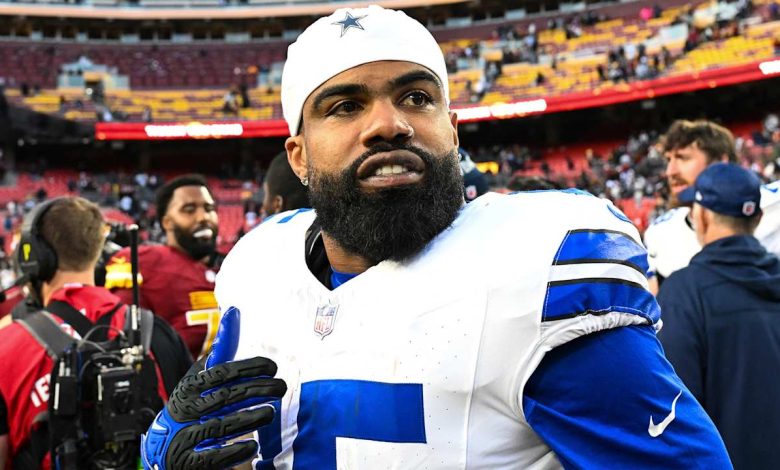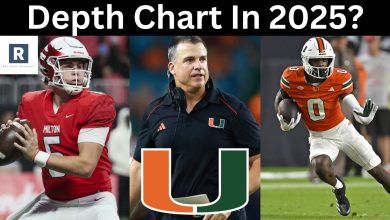Ezekiel Elliott is released by the Cowboys prior to the 2024 finale.

The announcement that Ezekiel Elliott, once the face of the Dallas Cowboys’ offense, was released by the team before the 2024 season finale was a moment that caught many by surprise. Elliott, drafted by the Cowboys as the fourth overall pick in the 2016 NFL Draft, had been an integral part of the team’s identity for nearly a decade. Over that time, he became synonymous with the Cowboys, known for his powerful running style, his leadership in the locker room, and his ability to take over games in critical situations.
However, as the 2024 season progressed, Elliott’s role within the Cowboys offense began to evolve. Once a cornerstone of the team’s high-powered offense, Elliott’s production had been slowly declining in recent years. A combination of factors—including the emergence of younger running backs, injuries, and a changing offensive philosophy—led to his release, marking the end of a storied chapter in Cowboys history.
In this article, we will explore the significance of Ezekiel Elliott’s release, the factors leading to his departure, the emotional impact on both Elliott and the Cowboys fanbase, and what this move means for the future of the team and Elliott’s career. It is a move that marks the end of an era for the Cowboys and raises questions about the evolving nature of the NFL running back position.
The Legacy of Ezekiel Elliott
Ezekiel Elliott’s career in Dallas was one marked by tremendous highs, including multiple 1,000-yard rushing seasons, Pro Bowl appearances, and a reputation as one of the most dominant running backs in the NFL. Upon being drafted in 2016, Elliott quickly proved his worth. In his rookie season, he led the league in rushing yards with an astounding 1,631 yards and scored 15 touchdowns, quickly becoming the focal point of the Cowboys’ offense. He helped propel the team to a 13-3 record and a playoff appearance in his first year, making an immediate impact that solidified him as one of the best young running backs in the league.
Over the next few seasons, Elliott’s production remained consistently strong. In 2018, he led the NFL in rushing yards once again, with 1,434 yards, and continued to be a workhorse for the Cowboys offense. His physical running style and ability to grind out tough yards between the tackles made him a central piece of the team’s attack, especially during critical moments. In addition to his rushing yardage, Elliott also contributed significantly in the passing game, showcasing his ability to catch passes out of the backfield.
However, as the years went on, Elliott’s dominance began to wane. A series of factors contributed to his declining performance, starting with a holdout during the 2019 offseason in which Elliott demanded a new contract. The Cowboys ultimately rewarded him with a six-year, $90 million contract extension, making him one of the highest-paid running backs in the league. Unfortunately, the contract extension and the added financial burden didn’t lead to the expected on-field production.
In the 2019 and 2020 seasons, Elliott’s rushing yards declined, and he struggled to maintain his level of consistency. Injuries, a weakened offensive line, and the emergence of younger, more dynamic running backs such as Tony Pollard all played a part in Elliott’s reduced role in the Cowboys offense. Despite his strong leadership and his reputation as a workhorse back, the Cowboys’ offense began to shift away from relying so heavily on the running game.
By 2024, the emergence of Pollard as the Cowboys’ primary running back made it clear that Elliott’s role was no longer sustainable at the level he had previously enjoyed. Pollard had proven to be more explosive and efficient in the backfield, and the Cowboys’ offense began to lean more heavily on its passing game, led by quarterback Dak Prescott. The shift in offensive philosophy, combined with Elliott’s declining performance, led to the decision to release him.
The Factors Behind Elliott’s Release
There were several factors that contributed to the Cowboys’ decision to part ways with Elliott before the 2024 season finale. Let’s explore some of the key reasons behind the release.
- Declining Performance and Injury Concerns: One of the most significant factors in Elliott’s release was his declining production on the field. While Elliott had been a workhorse for the Cowboys for several years, his yards per carry dropped significantly in recent seasons. In 2023, he rushed for just 800 yards and scored six touchdowns, his lowest totals since his rookie year. Additionally, Elliott had been plagued by injuries, including knee issues and ankle injuries, which hindered his ability to be as effective as he once was. The Cowboys were no longer getting the same explosive performances from Elliott that had made him one of the best running backs in the league.
- Emergence of Tony Pollard: The biggest reason for Elliott’s release was the emergence of Tony Pollard as the Cowboys’ new feature back. Pollard had been gradually taking on a larger role in the offense over the past few seasons, and in 2023, he solidified himself as the team’s primary running back. Pollard’s combination of speed, agility, and pass-catching ability made him a more dynamic option for the Cowboys offense. With Pollard taking on the majority of the workload and consistently providing big plays, the Cowboys no longer needed Elliott to be the focal point of their offense.
- Cap Space and Financial Considerations: Another important factor in Elliott’s release was the financial aspect. Elliott’s contract, which was one of the largest ever given to a running back at the time, became a financial burden for the Cowboys. In 2024, Elliott’s cap hit was over $16 million, and the Cowboys needed to free up space to make other moves and improve their roster. By releasing Elliott, they were able to save a significant amount of cap space, which could be used to sign key free agents or address other needs on the team.
- Shifting Offensive Philosophy: The Cowboys have increasingly become a pass-first offense under head coach Mike McCarthy. With Prescott leading the charge and an array of talented wide receivers such as CeeDee Lamb, Brandin Cooks, and Michael Gallup, the Cowboys have emphasized the passing game over the last few years. This shift away from a run-heavy offense made it less necessary to pay a premium for a high-priced running back like Elliott, especially with Pollard emerging as the lead back.
The Emotional Impact of the Release
Ezekiel Elliott’s release was not just a business decision for the Cowboys; it was an emotional one as well. For the team, Elliott had been the heart and soul of the franchise for nearly a decade. He had been the face of the Cowboys during some of their most memorable seasons and was known for his leadership, toughness, and ability to deliver in critical moments.
Elliott’s relationship with Cowboys fans and teammates was special. He had been with the team through thick and thin, and his iconic moments, such as his 2016 rookie season and his standout performances in the playoffs, had cemented his place as a fan favorite. His competitive spirit and on-field energy had helped define the Cowboys during the most successful years of his career.
For Elliott, this release marked the end of an era. The Cowboys were his team, and he had always expressed a desire to finish his career in Dallas. The emotional toll of leaving the organization that he had poured so much into was clear. He had been a central figure for the Cowboys and had helped lead them to multiple playoff appearances, but his departure signified a new era for both him and the franchise.
Following the announcement, Elliott took to social media to express his gratitude toward the Cowboys organization, his teammates, and the fans who supported him throughout his career. While the end of his time in Dallas was undoubtedly bittersweet, Elliott remained thankful for the opportunity to play for such a prestigious team.
What’s Next for Ezekiel Elliott?
While Elliott’s release marks the end of his tenure with the Cowboys, it does not signal the end of his NFL career. Although he is no longer a centerpiece for the Cowboys, Elliott is still a talented and capable running back. There will likely be interest from other NFL teams, particularly those looking for a veteran presence in their backfield or teams with injuries to their starting running backs.
Elliott’s future in the NFL will depend on his ability to adapt to a smaller role and become more of a complementary piece in an offense. He is no longer the workhorse back he once was, but he still has the potential to contribute in short-yardage situations and provide leadership in the locker room. His ability to catch passes out of the backfield could also make him an appealing option for teams looking to add a reliable third-down back.
Teams like the New England Patriots, Miami Dolphins, or Kansas City Chiefs—who all have varying degrees of need at running back—could consider signing Elliott to add depth to their backfield. While he may never return to the level of dominance he had in his early years with the Cowboys, he can still provide value as a veteran presence on a playoff-caliber team.









